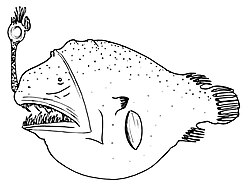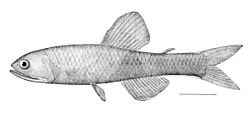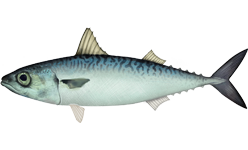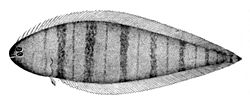| Genus | Species | Location | Member | Material | Notes | Images |
|---|
| Acentrophryne | A. sp. | City of Industry, Pomona Freeway Chalk Hill | Yorba | Articulated skeleton | An leftvent deep-sea anglerfish. [6] |  |
| Acipenseridae indet. | | | | Subopercule | A sturgeon of uncertain affinities. | |
| Argentina | A. sp. | Pomona Freeway Chalk Hill | | "Remains" | A herring smelt. |  |
| Argyropelecus | A. sp. | Pomona Freeway Chalk Hill | | Unknown | A marine hatchetfish. |  |
| Atherinops | A. sp. | Pomona Freeway Chalk Hill | | Unknown | A Neotropical silverside related to the modern topsmelt silverside. |  |
| Atherinopsis | A. sp. | Pomona Freeway Chalk Hill | | Unknown | A Neotropical silverside related to the modern jack silverside. |  |
| Bathylaginae indet. | | Pomona Freeway Chalk Hill | | Unknown | A deep-sea smelt. | |
| Borophryne | B. cf. apogon | LACM Locality 6202 | Yorba | Complete articulated skeleton | A leftvent deep-sea anglerfish, potentially referable to the modern netdevil. [5] |  |
| Chaenophryne | C. aff. melanorhabdus | LACM Locality 6202 | Yorba | 4 complete articulated skeletons | An oneirodid deep-sea anglerfish, potential affinities to the modern smooth dreamer. [5] |  |
| Chauliodus | C. eximius | Pomona Freeway Chalk Hill | | Unknown | A viperfish. |  |
| Cyclothone | C. sp. | Pomona Freeway Chalk Hill | | Unknown | A bristlemouth. |  |
| Decapterus | D. cf. hopkinsi | Continental Oil Company “Turnbull” well number 3 | Lower | One scale; lost | A scad. |  |
| D. sp. | Pomona Freeway Chalk Hill | | Unknown |
| Etringus | E. scintillans | Puente Hills | | Two scales; lost | A herring. | |
| Ganoessus | G. clepsydra | Featherstone Quarry | | Unknown | A herring. | |
| G. meiklejohni | Featherstone Quarry | | Articulated skeleton | |
| Ganolytes | G. cameo | Pomona Freeway Chalk Hill | | Unknown | A herring. | |
| Genyonemus | G. whistleri | Pomona Freeway Chalk Hill | | Partial articulated specimen. | A drumfish related to the white croaker. |  |
| Lampanyctus | L. sp. | Pomona Freeway Chalk Hill | | ">100 otoliths and several skeletal imprints with otoliths" | A lanternfish. |  |
| Leptacanthichthys | L. cf. gracilispinis | LACM Locality 6202 | Yorba | Articulated skeleton | An oneirodid deep-sea anglerfish, potentially referable to the modern plainchin dreamarm. [5] |  |
| Linophryne | L. cf. indica | LACM Locality 6202 | Yorba | Articulated skeleton | A leftvent deep-sea anglerfish, potentially referable to the modern headlight angler. [5] |  |
| Lompoquia | L. sp. | | Upper | Unknown | A drumfish. |  |
| Molidae indet. | | | | | An ocean sunfish of uncertain affinities. | |
| Moridae indet. | | Pomona Freeway Chalk Hill | | Unknown | A codling of uncertain affinities. | |
| Oneirodes | O. sp. | LACM Locality 6202 | Yorba | Articulated incomplete skeleton | An oneirodid deep-sea anglerfish. |  |
| Paralabrax | P. sp. | Pomona Freeway Chalk Hill | | Unknown | A sand bass. |  |
| Pseudoseriola | P. gilliandi | | | | A relative of the bluefish. | |
| Sarda | S. stockii | Union Oil Company “Chapman” well number 29 | Lower | 2 scales | A bonito. |  |
| Scomber | S. cf. japonicus | Continental Oil Company “Turnbull” well number 3 | Lower | 1 scale, lost | A mackerel, potentially referable to the modern chub mackerel. |  |
| S. sp. | Pomona Freeway Chalk Hill | | Unknown | A mackerel. |
| Seriphus | S. lavenbergi | City of Industry | Yorba | Disarticulated skull with otolith | A drumfish related to the queenfish. |  |
| Symphurus | S. sp. | Santiago Road Overcrossing | La Vida | 6 partial skeletons | A tonguefish. |  |
| Syngnathus | S. emeritus | San Dimas | | Several articulated skeletons | A pipefish. |  |
| Thyrsocles | T. kriegeri | Pomona Freeway Chalk Hill | | Unknown | A euzaphlegid. |  |
| Xyne | X. grex | Pomona Freeway Chalk Hill | | Unknown | A herring. | |
| ? Xyrinius | X. houshi | "Los Angeles" | | Unknown | A herring, from either the Monterey or Puente Formations. Potentially conspecific with Xyne grex. | |
| Zanteclites | Z. hubbsi | Covina, El Modena | | 6 specimens | A Neotropical silverside. | |























